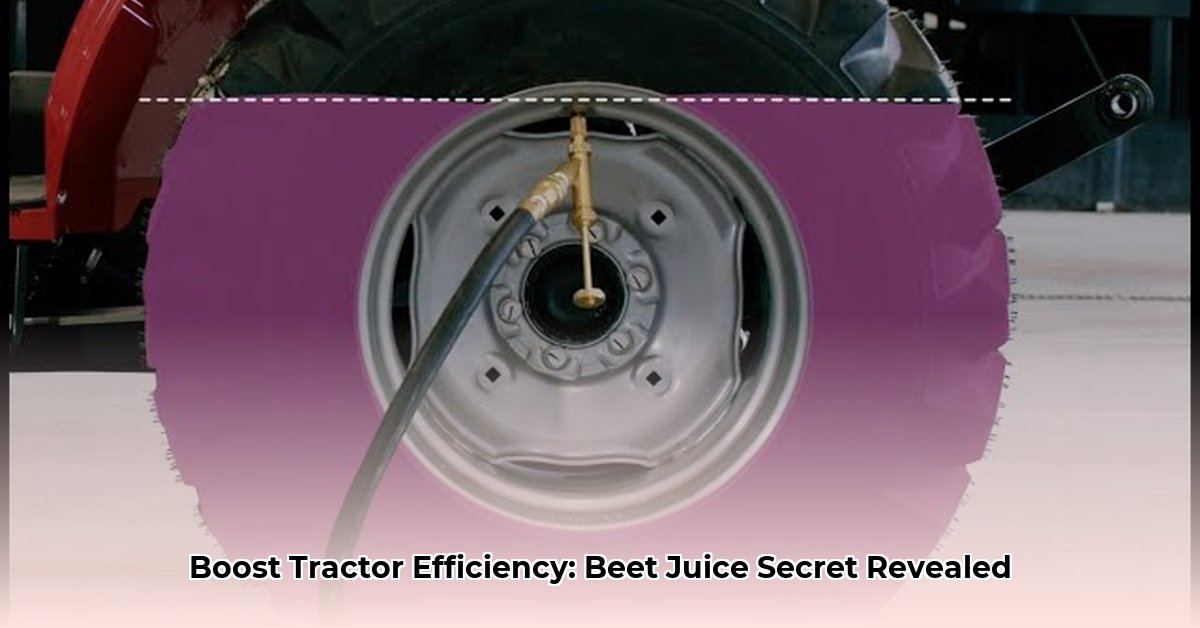
What is Beet Juice Ballast?
Traditional tire ballast, often sand or water, presents challenges: weight management, environmental impact, and cost. Beet juice ballast offers a sustainable alternative. It's heavier than water (approximately 25% denser), non-toxic, biodegradable, and non-corrosive, making it a compelling option for boosting tractor tire performance. For more unique uses of tractor parts, check out this interesting project.
| Property | Description |
|---|---|
| Density | ~10.7 pounds per gallon (approx. 25% denser than water) |
| Toxicity | Non-toxic, safe for animals and the environment |
| Biodegradability | Completely biodegradable |
| Corrosiveness | Non-corrosive, won't harm your tires |
| Environmental Impact | Significantly lower than traditional ballast options |
Isn't it remarkable how a readily available agricultural byproduct can offer such a significant upgrade to traditional practices?
Advantages of Beet Juice Ballast
Switching to beet juice ballast provides several key advantages:
Enhanced Traction: The increased weight directly translates to improved grip, especially on challenging terrain (muddy fields, hills). This leads to greater efficiency and reduced fuel consumption. How much fuel can you save? Further research is needed to quantify this precisely.
Improved Stability: Enhanced stability reduces the risk of rollovers, significantly improving safety. The even weight distribution contributes to a smoother, safer operation. How significant is the reduction in rollover risk? More research is needed to quantify this benefit.
Environmental Friendliness: Beet juice is a natural, biodegradable product, reducing your farm’s environmental footprint compared to traditional ballast materials.
Potential Cost Savings: While long-term cost-effectiveness requires further research, preliminary data suggests potential savings due to reduced fuel consumption and potentially lower material costs, especially if sourced locally. "Local sourcing can significantly reduce transportation costs," notes Dr. Amelia Hernandez, Agricultural Engineer at the University of California, Davis.
How to Use Beet Juice Ballast: A Step-by-Step Guide
This section provides a practical, step-by-step guide to using beet juice ballast.
Step 1: Sourcing Beet Juice: Contact local beet processing facilities to inquire about availability and pricing. Prioritize local sourcing to minimize transportation costs and support your local agricultural economy.
Step 2: Tire Preparation: Clean your tractor tires thoroughly. Inspect for any damage before filling. Ensure your valve stems are in good condition.
Step 3: Filling the Tires: Use a pump suitable for viscous, non-water substances. Avoid overfilling; adhere to your tractor's tire capacity recommendations.
Step 4: Monitoring and Maintenance: Regularly check tire pressure and ballast levels. Top off as needed. Regular inspection is vital for identifying any potential leaks early on.
Step 5: Troubleshooting: Address any leaks or other issues promptly to maintain optimal performance.
Addressing Concerns and Limitations
While offering many benefits, beet juice ballast presents some limitations:
- Availability: Supply may be seasonal or geographically restricted.
- Cost-Effectiveness: Further research is needed to fully confirm its long-term cost-effectiveness compared to all other options.
- Long-Term Environmental Impact: Ongoing research is necessary to assess the long-term effects of widespread use and disposal methods.
These limitations highlight the need for further research, particularly in evaluating the long-term cost-effectiveness and environmental impact.
Regulations and Safety
Always adhere to local regulations concerning the handling and disposal of beet juice ballast. Appropriate safety gear (gloves, eye protection) is recommended during filling.
Conclusion
Beet juice ballast presents a sustainable and potentially cost-effective alternative to traditional tire ballasting methods. While further research is needed to fully quantify some benefits and address certain limitations, its significant advantages in traction, stability, and environmental impact make it a promising option for modern farming.
Resources
Further research and resources will be added to this section as they become available. Check back for updates.